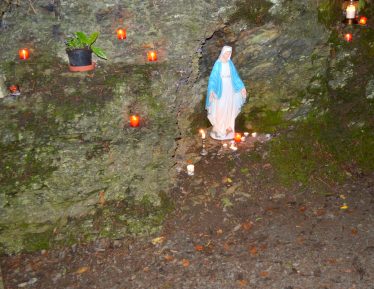Saint Martin’s Holy Well, Ballynacally





Townland: Ballynacally Village (Kilchreest)
Description of Holy Well and Landscape Setting
This well is located on the west bank of the Ballynacally River, at the end of Ballynacally Village on the main R473 road heading south-west to Kildysert. The site of the well is located between the river and a low cliff wall. A feature of the Ballynacally blessed well practice is night visitation when the walls and grottos are festooned with lighted candles. A miniature Lourdes grotto has been installed in the lower part of the well site. A number of other religious statues are found in the recesses in the wall.
Saint and Feast Day Associated with Holy Well
The saint associated with this holy well is Saint Martin of Tours, France. He is best known in Clare for his association with Saint Senan of Scattery Island. Some folk tales tell of Saint Martin and Saint Senan meeting, which is not likely as Martin died in 397 AD and Senan wasn’t born until 488 AD.
A more credible story tells of Senan visiting Tours on his return journey from Rome and being gifted a relic of Saint Martin, which he brought with him to Ireland.
There is still veneration of this French saint in West Clare, perhaps begun by Saint Senan. The Feast day of Saint Martin is known as Martinmas and takes place on 11th November.
According to records in the Irish Folklore Collection, the well water is said to hold a cure for sore eyes, sore feet and rheumatism. Mary Hester writes that no record of any particular rounds at this well has been found.
Natural Heritage around the Holy Well
Some alder and ash are present on the banks near the well. .
Heritage Attractions Nearby
The village of Ballynacally is the gateway to the islands of the Fergus and Shannon estuaries. These include Canon Island where there is a 12th century Augustinian Monastery.
Additional Information
Amhlaoibh Ó Suilleabháin, who kept a diary between 1827 and 1835, wrote the following about Martinmas Eve in his diary entry for 10th November, 1830:
‘It is usual to shed blood on Martinmas Eve; this is to say blood of goose or gander, hen or cock, pullet or chicken, duck or drake, fat poker or great and good beef, big wether or bleating kid; blood of sprightly lamb or gentle sheep or ragged goat or some other good meat. It is a good old custom which ought to be kept up wherever no butcher’s meat is be had. Every strong farmer and every country gentleman ought to kill a sheep or a beef or a porker and share it with the hovel dwellers of the neighbourhood, and with God’s poor’.
Other Saint Martin holy wells in Clare include a fine well at Clarefield, Moyarta, with another at Cooga, Kiladysert, with a third at Leamaneh North, Killinaboy.
Discover More…
Diary of an Irish Countryman 1827-1835 by Amhlaoibh Ó Súilleabháin
Amhlaoibh Ó Súilleabháin, Royal Irish Academy
Hester, M ‘The Holy Wells of Ballynacally and Lissycasey’, The Other Clare, vol.39, pp 74-77
Record of Monuments and Places Number
RMP-CL050-039




No Comments
Add a comment about this page